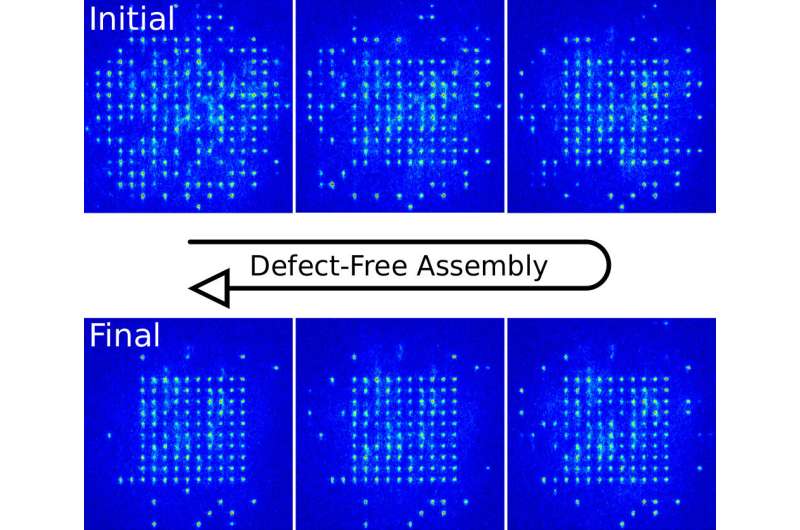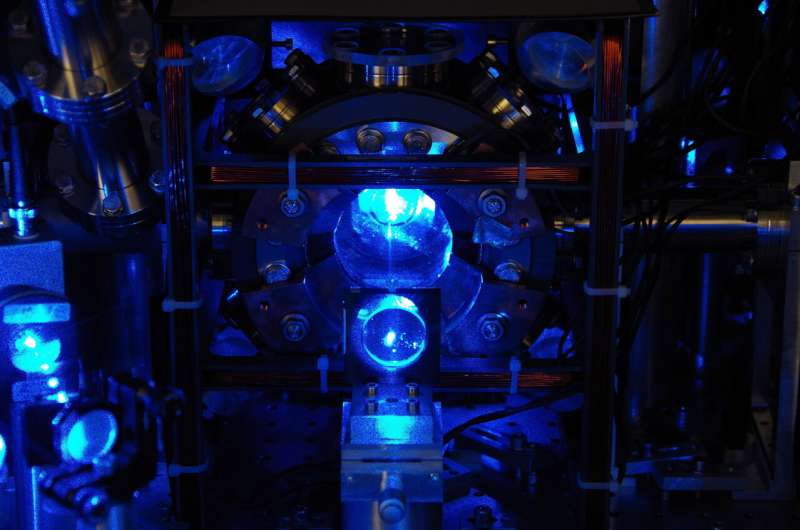Atom pattern assembly: an initial atom distribution with defects is transferred into a defect-free 100 atom target cluster via single-atom transport. Credit: Gerhard Birkl
Researchers at Technische Universität Darmstadt have recently demonstrated the defect-free assembly of versatile target patterns of up to 111 single-atom quantum systems. Their findings, outlined in a paper published in Physical Review Letters, could drive assembled-atom architectures beyond the threshold of quantum advantage, paving the way for new breakthroughs in quantum science and technology.
"Our research is driven by the observation that physical sciences are right in the middle of a paradigm shift in which the application of quantum physics, i.e. quantum technologies, are becoming the leading technologies in the near future," Gerhard Birkl, one of the researchers who carried out the study, told Phys.org. "A vast list of applications are already foreseeable but I am convinced that of most applications we are not even aware of."
The next step for the field of quantum science and technology is the development of experimental platforms that offer extensive scalability, multisite quantum correlations and efficient quantum error correction. Over the past century or so, researchers have carried out a substantial amount of work on single quantum systems, laying the foundations for current developments. Atomic quantum systems have played a key role in these studies, particularly neutral atoms trapped by light, as they provide well-isolated quantum systems with favorable scaling.
"For the upcoming generations of quantum technologies, going to multiple quantum systems, i.e. scaling up the system size is pivotal," Birkl said. "For that reason we gave ourselves the directive to develop a novel platform that provides highly scalable architectures for atomic quantum systems with full control of all relevant parameters for advancing state-of-the art quantum technologies."
When developing the technological basis for their experiment, Birkl and his students who were involved in the study focused on laser cooled neutral atoms with in optical traps, as these benefit from scientific breakthroughs of the past 25 years. These breakthroughs include laser cooling and trapping, Bose-Einstein condensation, the manipulation of individual quantum systems, and optical tweezers.
"Finally, we realized that the combination of these scientific developments with advanced optical technologies such as microfabrication of large-scale arrays of microlenses generates an ideal platform for the advancement of scalable quantum technologies," Birkl said. "Central to our work is that we apply a novel experimental architecture in which we generate a 2-D pattern of optical traps for neutral atoms based on 2-D arrays of microlenses."
Using a large laser beam that illuminates many lenses, the researchers were able to generate several laser traps simultaneously. They generated up to 400 of these traps in parallel and were then able to address them individually.
Their experiment had several steps. Birkl and his colleagues started by creating a cloud of rubidium atoms in a room-temperature vacuum system, using a magneto-optical trap (MOT). This allowed them to generate several million rubidium atoms at a temperature of about 100 microKelvin. Subsequently, they turned on the pattern of laser traps and transferred atoms into these traps, with a maximum of 1 atom per trap.
Central part of the experimental apparatus for the arrangement of rubidium atoms in defect-free 2D target patterns. The blue laser light is used to initiate coherent quantum operations. Credit: Gerhard Birkl
"We generated patterns that are consisting of trap sites with exactly one or zero atoms," Birkl explained. "Next, we took an image of the pattern and this allowed us to identify the occupied sites (which required no further action) and empty sites."
Once they determined which sites were occupied and which vacant, the researchers filled all empty sites; picking up a single atom out of a filled site outside the target pattern and transporting it to an empty site in the target pattern. This transport process was carried out using a single focus laser beam that could move in 2-D throughout the whole trap array.
"This works like tweezers made out of light, for which reason they are referred to as 'Optical Tweezers' and are the invention of Dr. Arthur Ashkin who received part of the 2018 Nobel Prize in Physics for this invention," Birkl said. "After applying the tweezers for all empty sites, we take another image of the atom distribution and determine success of the process of generating defect-free atom patterns. In case we still have empty sites, we repeat the assembly process one more time. We can do this up to 80 times in one experimental run, which is another reason for our success in generating large defect-free patterns with high probability."
In their study, the researchers operated on a large number of traps (361), placed in a square grid of 19x19, which corresponded to a substantial number of single atoms (approximately 200) and this allowed them to repeat the assembly process numerous times. All these factors ultimately assisted them in breaking the previous record for the assembly of single-atom quantum systems.
"The scalability of the physical systems used is pivotal to further progress in this field," Birkl said. "We were able to significantly increase the pattern size and the success probability of systems based on neutral atoms. No related experiment has demonstrated more than 72 qubits before, needless to say more than 100, or even 111. Our platform has the explicit prospect of being scalable even far beyond that numbers."
Quantum supremacy typically requires over 50 qubits, yet so far only a few quantum technology experiments were able to surpass this threshold. In their experiment, the researchers reached a total of 111 qubits with a clear plan of how to further exceed this number. This is evidence of the scalability of their experimental platform.
"In addition, we could get into the regime of quantum supremacy with high success rates, as we demonstrated a success rate of more than 60% for a pattern with 8x8 = 64 qubits," Birkl added. "With the duration of one experimental run of 1 second, this gives a new defect-free configurations for quantum processing in the regime of quantum supremacy every two seconds."
The study carried out by Birkl and his team could have important implications for several subfields of quantum technology research, including quantum simulation and quantum computing. The researchers are now planning to scale up their platform to 1000 quantum systems, also adding the ability to initiate two-qubit quantum gates between atoms to build a 2-D quantum processor based on Rydberg interactions. In this way, they are also hoping to implement large-scale quantum computing and quantum simulations using their experimental platform.
More information: Daniel Ohl de Mello et al. Defect-Free Assembly of 2D Clusters of More Than 100 Single-Atom Quantum Systems, Physical Review Letters (2019). DOI: 10.1103/PhysRevLett.122.203601
Journal information: Physical Review Letters
© 2019 Science X Network

























